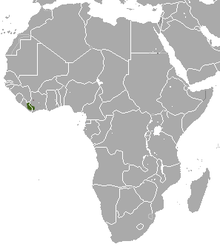Leighton's linsang
| Leighton's Linsang | |
|---|---|
| Scientific classification | |
| Kingdom: | Animalia |
| Phylum: | Chordata |
| Class: | Mammalia |
| Order: | Carnivora |
| Family: | Viverridae |
| Subfamily: | Viverrinae |
| Genus: | Poiana |
| Species: | P. leightoni |
| Binomial name | |
| Poiana leightoni (Pocock, 1908) | |
 | |
| Leighton's linsang range (green - extant, pink - probably extant) | |
Leighton's linsang (Poiana leightoni), also known as the West African linsang and West African oyan, is a linsang species native to the Upper Guinean forests.[1]
It was formerly classified as Poiana richardsonii leightoni and considered a subspecies of the oyan.
Description
Leighton's linsang is similar to the African linsang, It is a small, thin viverrid which has a body length measures between 30 to 38 cm (12 to 15 in) long, the tail is 35 to 40 cm (14 to 16 in) long, giving a total length of 65 to 78 cm (26 to 31 in), it weighs 500 to 700 g (18 to 25 oz). The base colour of the pelage is yellowish brown on the back and whitish on the underparts. The back is patterned with irregular patches of dark colour with a dark band along the spine, although this can sometimes be interrupted.[2]
Habitat and distribution
Leighton's linsang is found in the tropical forests of Liberia and the Ivory Coast, its occurrence in the Kounounkan forest in the south west of Guinea requires confirmation. It is an inhabitant of the canopy of tropical forests.[2]
Conservation
Leighton's linsang is listed as Vulnerable because the likely total population is 6,700–10,000 mature individuals (a rough estimate based on a range area of roughly 50,000 km2 (19,000 sq mi), an average population density highly unlikely to exceed 2–3 individuals per 10 km2 (3.9 sq mi), and a proportion of adults of 67%) while the population has probably declined by at least 10% in the last 12 years based on the rate of deforestation in its known habitat the upper Guinea forests, and adding in effects of hunting.[3]
Like the sympatric Johnston's Genet Genetta johnstoni, Bourlon's Genet Genetta bourloni and Liberian Mongoose Liberiictis kuhni, Leighton's linsang is thought to be adversely affected by continuing habitat loss in the upper Guinean forests, exacerbated because this is a canopy species. It is not clear to what impact bush meat hunting affects this semi-arboreal species, but this could well have an impact as most of the specimens collected by scientists were acquired from hunters, although it is unclear it is used as bushmeat, for its pelt or in traditional medicine. . Further study of this little know carnivore should be undertaken to ascertain its status and conservation requirements.[3]
Taxonomy
Leighton's linsang was formerly considered a subspecies of African linsang Poiana richardsonii, but is now regarded as a separate species.[3]
References
- 1 2 Gaubert, P. & Do Linh San, E. (2015). "Poiana leightoni". IUCN Red List of Threatened Species. Version 2016.2. International Union for Conservation of Nature.
- 1 2 "Linsang de Leighton (Poiana leightoni)". manimalworld.net. Retrieved 16 October 2016.
- 1 2 3 "Poiana leightoni (Leighton's Linsang, West African Linsang, West African Oyan)". International Union for Conservation of Nature and Natural Resources. Retrieved 16 October 2016.
